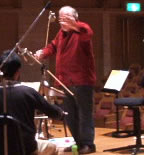The Corporal Quartet Breathing: Everybody’s fascination! For as many wind instrument and voice
teachers as there are, there are that many theories on what is the right way
to breathe. Everyone agrees that breathing should be natural and simple but too
frequently the results only become more complicated. Breathing is part of the
music. Breathing: Everybody’s fascination! For as many wind instrument and voice
teachers as there are, there are that many theories on what is the right way
to breathe. Everyone agrees that breathing should be natural and simple but too
frequently the results only become more complicated. Breathing is part of the
music.
These four mechanisms, breathing, embouchure, articulation and fingering form a quartet of musical functions, a corporal quartet, that we spend our musical lives coordinating and fine-tuning. But there is something missing. Who’s in charge? Who is the conductor? Of course, it’s our brain, and particularly the part of our brain that determines our musicality, that conducts this corporal quartet. And like in any ensemble it is the conductor’s responsibility to get the ensemble to function together as one, and, of course, the conductor has to be clever in order to get those results he envisions. Lets create a scenario: You are rehearsing a trombone quartet and working on a fast passage. Everybody is playing well except the 3rd trombone, he’s a little slow; what do you do? The first step is to give the responsibility to the 3rd player; it could go like this, "Excuse me Mr. 3rd trombone player, you have a very important part in this passage. If you could rhythmically lead here, it would make it easier for the other three players to keep it moving." Hopefully, the 3rd player will respond and the passage will come together. The exact same scenario could take place with the corporal quartet. This time, lets make fingering be the slow member, as it often is. By giving responsibility to the fingers to lead the other quartet members, air, embouchure and tongue, the problem will probably be corrected. Ideally, we can simply practice and things will come together without analysis, but sometimes everyone has to take a realistic look at where the problem is and take the right steps to correct it. Fingering so often falls behind in the corporal quartet, especially with the tuba, because we simply do not hear as clearly in the lower tessitura as well as we do in higher registers. Also, because the tuba has the largest sound in the symphony orchestra, it is one of the most difficult instruments to articulate. With its sonic mass, clarity in rapid passages can be too easily overlooked and compromised. Playing the same passage two octaves higher on trumpet simply would not allow the same imperfections that frequently occur on the tuba. I will discuss this in another article very soon called "FINGERING."
All successful players become successful self teachers. It’s the same as being a successful conductor of your corporal quartet... and almost everyone wants to be a conductor! Tokyo, February 20, 2006 |


 Embouchure: As we concentrate on the embouchure, making it stronger, playing
higher, lower, louder or softer, we often forget that nothing would happen
if it weren’t for our brass playing power air. Embouchure is a verb,
an action verb.
Embouchure: As we concentrate on the embouchure, making it stronger, playing
higher, lower, louder or softer, we often forget that nothing would happen
if it weren’t for our brass playing power air. Embouchure is a verb,
an action verb. Articulation: The nearly infinite number of ways that we can start and end
notes. Articulation is the fine-tuning of rhythm; articulation is the consonance
of the musical language.
Articulation: The nearly infinite number of ways that we can start and end
notes. Articulation is the fine-tuning of rhythm; articulation is the consonance
of the musical language. When the corporal quartet works well together, we are able to concentrate
on musical matters and depend on all the aspects of function to be at our simultaneous
demand.
When the corporal quartet works well together, we are able to concentrate
on musical matters and depend on all the aspects of function to be at our simultaneous
demand.